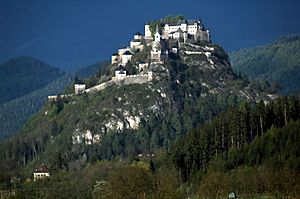Defence in depth facts for kids
Defense in depth is a clever military strategy. It's also called deep defense or elastic defense. This plan aims to slow down an enemy's advance instead of stopping them right away. It buys time by letting the enemy move forward slowly. This tactic often causes the enemy to lose more soldiers. A defense in depth can make an attacking army lose its momentum.
Contents
How does defense in depth work?
A well-planned defense in depth can reduce any advantage an attacking force might have. This includes having more soldiers. The defenders place the important thing they are protecting behind several layers of defense. The defenders then let the attacker wear down their forces. They slowly give up ground and move back to the next layer of defense.
Famous military thinkers like Carl von Clausewitz and Sun Tzu believed that defending was often the best way to fight. Defense gives the defenders more chances to win. A defense in depth can stop an enemy from surrounding your position. It also creates good chances for a Counterattack.
- A defense in space means not being in a certain place when an enemy attacks.
- A defense in time means slowing down or blocking an enemy when they do attack.
Historical examples of this strategy
This strategy has been used successfully throughout history.
Hannibal's clever plan at Cannae
Hannibal used this tactic at the Battle of Cannae in 216 BC. He faced a much larger Roman army. Hannibal put his less experienced soldiers in the middle of his battle line. His most experienced fighters were on the sides. When the Romans attacked, his center slowly moved backward. At the same time, his troops on the sides began to surround the Romans. This battle was one of the biggest defeats for Roman soldiers in their history.
Medieval castles and their strong walls
A classic example is Medieval hill forts and castles. They had many rings of defenses, usually walls. The defenders inside the castle could shoot missiles at attackers from the inner walls. Attackers had to break through each line of defense. This made them tired and used up their strength.
German army tactics in World War I
The German army used this tactic in 1917 during World War I. The Germans used it very well against both the French and British armies. This continued until July 1918. The arrival of American forces helping the French and British eventually ended the German tactic.
What is a delaying action?
A similar tactic is called a delaying action. Here, a smaller force tries to harass a larger force. They want to slow down the enemy's advance. They also try to cause as much damage as possible without fighting directly. The goal of a delaying action is to let an army's main force escape an enemy safely. It gives the main force time to set up a new defensive position. The small force protecting the larger army is called a rearguard.
A famous rearguard example is found in the Song of Roland. Roland, who was the nephew of Charlemagne, led the rearguard at the Battle of Roncevaux Pass. He and his men protected the back of the Frankish army. This allowed the main army to retreat back to France. In this delaying action, Roland and his men were all killed in an ambush.
See also
 In Spanish: Defensa en profundidad para niños
In Spanish: Defensa en profundidad para niños


